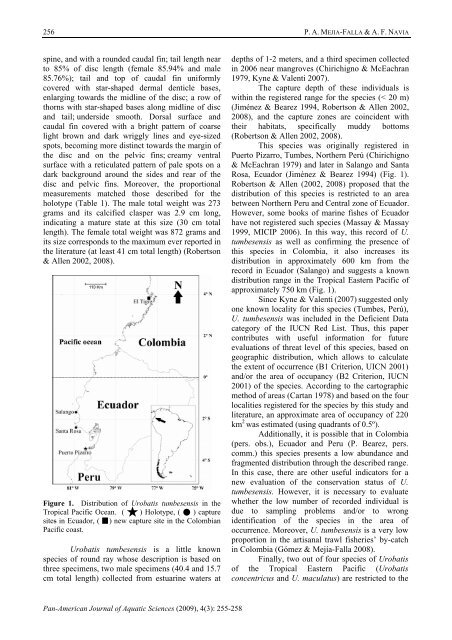Download full issue - PanamJAS
Download full issue - PanamJAS
Download full issue - PanamJAS
Create successful ePaper yourself
Turn your PDF publications into a flip-book with our unique Google optimized e-Paper software.
256<br />
P. A. MEJIA-FALLA & A. F. NAVIA<br />
spine, and with a rounded caudal fin; tail length near<br />
to 85% of disc length (female 85.94% and male<br />
85.76%); tail and top of caudal fin uniformly<br />
covered with star-shaped dermal denticle bases,<br />
enlarging towards the midline of the disc; a row of<br />
thorns with star-shaped bases along midline of disc<br />
and tail; underside smooth. Dorsal surface and<br />
caudal fin covered with a bright pattern of coarse<br />
light brown and dark wriggly lines and eye-sized<br />
spots, becoming more distinct towards the margin of<br />
the disc and on the pelvic fins; creamy ventral<br />
surface with a reticulated pattern of pale spots on a<br />
dark background around the sides and rear of the<br />
disc and pelvic fins. Moreover, the proportional<br />
measurements matched those described for the<br />
holotype (Table 1). The male total weight was 273<br />
grams and its calcified clasper was 2.9 cm long,<br />
indicating a mature state at this size (30 cm total<br />
length). The female total weight was 872 grams and<br />
its size corresponds to the maximum ever reported in<br />
the literature (at least 41 cm total length) (Robertson<br />
& Allen 2002, 2008).<br />
Figure 1. Distribution of Urobatis tumbesensis in the<br />
Tropical Pacific Ocean. ( ) Holotype, ( ) capture<br />
sites in Ecuador, ( ) new capture site in the Colombian<br />
Pacific coast.<br />
Urobatis tumbesensis is a little known<br />
species of round ray whose description is based on<br />
three specimens, two male specimens (40.4 and 15.7<br />
cm total length) collected from estuarine waters at<br />
depths of 1-2 meters, and a third specimen collected<br />
in 2006 near mangroves (Chirichigno & McEachran<br />
1979, Kyne & Valenti 2007).<br />
The capture depth of these individuals is<br />
within the registered range for the species (< 20 m)<br />
(Jiménez & Bearez 1994, Robertson & Allen 2002,<br />
2008), and the capture zones are coincident with<br />
their habitats, specifically muddy bottoms<br />
(Robertson & Allen 2002, 2008).<br />
This species was originally registered in<br />
Puerto Pizarro, Tumbes, Northern Perú (Chirichigno<br />
& McEachran 1979) and later in Salango and Santa<br />
Rosa, Ecuador (Jiménez & Bearez 1994) (Fig. 1).<br />
Robertson & Allen (2002, 2008) proposed that the<br />
distribution of this species is restricted to an area<br />
between Northern Peru and Central zone of Ecuador.<br />
However, some books of marine fishes of Ecuador<br />
have not registered such species (Massay & Massay<br />
1999, MICIP 2006). In this way, this record of U.<br />
tumbesensis as well as confirming the presence of<br />
this species in Colombia, it also increases its<br />
distribution in approximately 600 km from the<br />
record in Ecuador (Salango) and suggests a known<br />
distribution range in the Tropical Eastern Pacific of<br />
approximately 750 km (Fig. 1).<br />
Since Kyne & Valenti (2007) suggested only<br />
one known locality for this species (Tumbes, Perú),<br />
U. tumbesensis was included in the Deficient Data<br />
category of the IUCN Red List. Thus, this paper<br />
contributes with useful information for future<br />
evaluations of threat level of this species, based on<br />
geographic distribution, which allows to calculate<br />
the extent of occurrence (B1 Criterion, UICN 2001)<br />
and/or the area of occupancy (B2 Criterion, IUCN<br />
2001) of the species. According to the cartographic<br />
method of areas (Cartan 1978) and based on the four<br />
localities registered for the species by this study and<br />
literature, an approximate area of occupancy of 220<br />
km 2 was estimated (using quadrants of 0.5º).<br />
Additionally, it is possible that in Colombia<br />
(pers. obs.), Ecuador and Peru (P. Bearez, pers.<br />
comm.) this species presents a low abundance and<br />
fragmented distribution through the described range.<br />
In this case, there are other useful indicators for a<br />
new evaluation of the conservation status of U.<br />
tumbesensis. However, it is necessary to evaluate<br />
whether the low number of recorded individual is<br />
due to sampling problems and/or to wrong<br />
identification of the species in the area of<br />
occurrence. Moreover, U. tumbesensis is a very low<br />
proportion in the artisanal trawl fisheries’ by-catch<br />
in Colombia (Gómez & Mejía-Falla 2008).<br />
Finally, two out of four species of Urobatis<br />
of the Tropical Eastern Pacific (Urobatis<br />
concentricus and U. maculatus) are restricted to the<br />
Pan-American Journal of Aquatic Sciences (2009), 4(3): 255-258
















